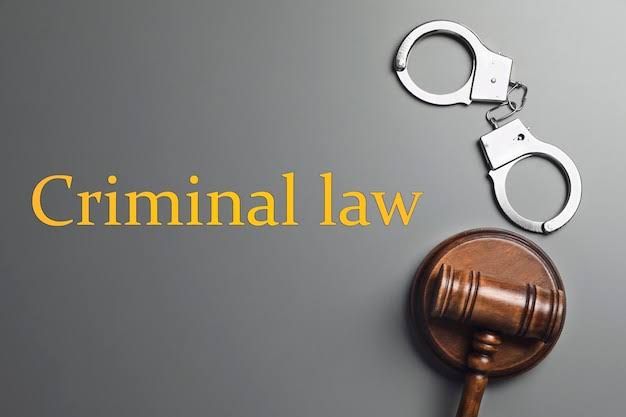ARTICLE ON FUNDAMENTAL ON CRIMINAL LAW
CRIME: “An Unlawful Act against the Society”. ;
- Define as a legal wrong for which the remedy is punishment.
Criminal law is a vital pillar of any legal system, designed to maintain order, protect individuals, and ensure justice within society. It delineates behaviours deemed unacceptable and prescribes punishments for those who engage in such conduct.
Criminal law is a branch of law that pertains to crimes and punishment. It is a fundamental aspect of a legal system, designed to maintain social order, deter wrongful conduct, and provide justice for victims of crime. The primary aim of criminal law is to define conduct that is unacceptable to society and to prescribe punishments for those who engage in such conduct.
- Historical Development of Criminal Law:
The evolution of criminal law can be traced back to ancient legal codes, with significant reforms emerging during the Enlightenment era. Thinkers like Cesare Beccaria and Jeremy Bentham advocated for rational, proportionate punishments and emphasized the prevention of crime over retribution. This philosophical shift laid the groundwork for modern criminal justice systems, which focus not only on punishment but also on the rehabilitation of offenders and deterrence of future crimes.
Early legal codes, such as the Code of Hammurabi and the Roman Twelve Tables, laid the groundwork for modern criminal law by defining various offenses and their corresponding punishments. These early laws were often harsh and retributive, reflecting the societal norms and values of the time.
With the advent of the Enlightenment in the 17th and 18th centuries, criminal law began to evolve. Thinkers such as Cesare Beccaria and Jeremy Bentham advocated for reforms, emphasizing rationality, proportionality, and the prevention of crime. Beccaria’s seminal work, “On Crimes and Punishments,” argued against torture and the death penalty, promoting the idea that the purpose of punishment should be to deter crime and rehabilitate offenders.
Criminal law forms the backbone of a society’s legal system, governing the behaviors that are considered unacceptable and defining the consequences for violating these laws. Understanding the fundamentals of criminal law is essential not only for law students but for anyone interested in the legal system. This article will provide an overview of key concepts, elements of a crime, and the types of offenses and defences in criminal law.
- Key Concepts in Criminal Law:
Criminal law is a body of laws pertaining to crimes, including the punishment and rehabilitation of offenders. Its primary purpose is to maintain public order and safety, protect individuals, and provide justice. The key concepts in criminal law include the following:
1. Actus Reus (Guilty Act): This refers to the physical act of committing a crime. To be found guilty, it must be proven that the defendant engaged in a voluntary act that caused harm or damage.
2. Mens Rea (Guilty Mind): This is the mental element of a crime, referring to the defendant’s intent or state of mind at the time of the criminal act. Different crimes require different levels of mens rea, ranging from negligence to intent.
3. Causation: This links the defendant’s actions to the resulting harm. The prosecution must show that the defendant’s conduct was the actual cause of the victim’s injury or loss.
4. Concurrence: This principle requires that the actus reus and mens rea occur together to constitute a crime. The guilty mind must be present while the guilty act is committed.
5. Harm: Harm must result from the act, and it can be physical, emotional, or financial. Not all harmful acts are crimes, but all crimes involve harm.
- Presumption of Innocence:
A cornerstone of criminal law is the presumption of innocence. This principle asserts that a defendant is considered innocent until proven guilty. The burden of proof lies squarely on the prosecution, which must establish the defendant’s guilt beyond a reasonable doubt. This high standard of proof serves to protect individuals from wrongful convictions and ensures that the justice system errs on the side of caution. The presumption of innocence is crucial for maintaining public trust in the legal system. It emphasizes the notion that it is better for a guilty person to go free than for an innocent person to be wrongfully convicted. This principle is deeply rooted in democratic societies and is a fundamental safeguard of individual liberties.
- Elements of a Crime:
To secure a conviction in a criminal case, the prosecution must establish certain elements beyond a reasonable doubt. These elements typically include:
1. The Act (Actus Reus): The prosecution must prove that the defendant committed a voluntary act or unlawful omission. This element focuses on the physical conduct of the defendant.
2. The Mental State (Mens Rea): The prosecution must demonstrate that the defendant had the requisite mental state or intent at the time of the act. The specific level of mens rea required varies depending on the offense.
3. Causation: The prosecution must show that the defendant’s conduct caused the harm or result in question. This includes both factual causation (but-for test) and legal causation (proximate cause).
4. Concurrence: The actus reus and mens rea must occur together. The defendant must have had the criminal intent at the same time as the criminal act was committed.
5. Harm: The prosecution must prove that the defendant’s conduct resulted in harm or damage to a legally protected interest.
- Types of Criminal Offenses:
Criminal offenses are generally categorized into 2 :
1. Felonies: These are serious crimes, such as murder, rape, and armed robbery, typically punishable by imprisonment for more than one year or even death.
2. Misdemeanors: These are less severe offenses, including petty theft, vandalism, and public intoxication, usually punishable by fines or imprisonment for less than one year.
Within these categories, crimes can also be classified based on the nature of the offense, such as violent crimes, property crimes, white-collar crimes, and drug-related offenses.
- The Criminal Justice Process:
The criminal justice process encompasses several stages, from the investigation of a crime to the final resolution of a case. The key stages include:
1. Investigation: Law enforcement agencies investigate suspected criminal activity by gathering evidence, interviewing witnesses, and identifying suspects.
2. Arrest: If there is probable cause to believe that a person has committed a crime, they may be arrested and taken into custody.
3. Charging: The prosecutor reviews the evidence and decides whether to file formal charges against the suspect. This decision relies on the strength of the evidence and the probability of obtaining a conviction.
4. Initial Appearance: The defendant is brought before a judge for an initial appearance, where they are informed of the charges and their rights. At this point, bail might be determined.
5. Preliminary Hearing/Grand Jury: In some jurisdictions, a preliminary hearing or grand jury proceeding is held to determine whether there is sufficient evidence to proceed to trial.
6. Arraignment: The defendant is formally charged and enters a plea of guilty, not guilty, or no contest. If the defendant enters a plea of not guilty, the case advances to trial .
7. Trial: During the trial, the prosecution and defense present evidence and arguments to a judge or jury. The burden is on the prosecution to prove the defendant’s guilt beyond a reasonable doubt.
8. Verdict: The judge or jury delivers a verdict of guilty or not guilty. If the defendant is convicted, the case proceeds to the sentencing stage.
9. Sentencing: The judge imposes a sentence based on the severity of the crime, the defendant’s criminal history, and other relevant factors. Sentences can include imprisonment, fines, probation, or community service.
10. Appeal: The defendant has the right to appeal the conviction or sentence if there are grounds to believe that legal errors occurred during the trial.
- Defences in Criminal Law
Defendants can raise several defences to avoid liability, including:
1. Insanity: Arguing that the defendant was unable to understand the nature of the act or distinguish right from wrong due to a mental disorder.
2. Self-Defense: Claiming that the act was justified as it was necessary to protect oneself from imminent harm.
3. Duress: Asserting that the defendant was forced to commit the crime under the threat of immediate danger.
4. Entrapment: Contending that the defendant was induced to commit the crime by law enforcement officials.
5. Mistake of Fact: Arguing that a genuine misunderstanding of a fact negates a necessary element of the crime.
6. Alibi: Providing evidence that the defendant was elsewhere when the crime was committed.
- Conclusion:
Criminal law is essential for maintaining societal order and protecting individuals from harm. It balances the need for punishment with the principles of fairness and justice, ensuring that only those who are truly culpable are penalized, and that the punishments are proportionate to the crimes committed. Through its structured processes and adherence to fundamental principles, criminal law plays a crucial role in upholding the rule of law and safeguarding the rights of individuals within society. It also critical in ensuring justice within society by defining unacceptable behaviours and prescribing appropriate punishments. By understanding key concepts such as actus reus, mens rea, and the types of offenses and defences, individuals can gain insight into the complexities of the criminal justice system. This knowledge is vital for law students, legal professionals, and anyone interested in how laws shape and protect our communities.
- FAQ :
Q1: What is criminal law?
A1: Criminal law is the body of law that pertains to crime. It defines conduct considered unacceptable by society, prescribes punishments for those behaviours, and sets the legal procedures for investigating and prosecuting offenses.
Q2: What are the main purposes of criminal law?
A2: The primary purposes of criminal law are to maintain public order and safety, protect individuals, and provide retribution and rehabilitation for offenders.
Q3: What are the essential elements of a crime?
A3: The essential elements of a crime typically include a prohibited act (actus reus), a culpable mental state (mens rea), and causation. These elements must be proven beyond a reasonable doubt to establish criminal liability.
Q5: What is mens rea, and why is it important?
A5: Mens rea, or “guilty mind,” refers to the mental state of the defendant at the time of the crime. It is important because it helps determine the defendant’s intent and level of culpability.
Q6: What is actus reus?
A6: Actus reus, or “guilty act,” is the physical act or unlawful omission that constitutes a crime. It must be a voluntary action that results in harm or is prohibited by law.
Q7: What is the burden of proof in a criminal case?
A7: The burden of proof in a criminal case is “beyond a reasonable doubt.” This means the evidence presented by the prosecution must be so convincing that there is no reasonable
doubt about the defendant’s guilt
Q8:How is a trial court distinct from an appellate court?
A8: A trial court is where the case is initially heard, and evidence is presented. An appellate court reviews the trial court’s decision to ensure the correct application of law and procedure, often without new evidence.
Q9: What are some common types of crimes?
A9: Common types of crimes include violent crimes (e.g., murder, assault), property crimes (e.g., theft, burglary), white-collar crimes (e.g., fraud, embezzlement), and drug offenses.
AUTHOR: Chestha Sharma , B.COM LL.B (7 Semester) , Greater Noida College of Law



